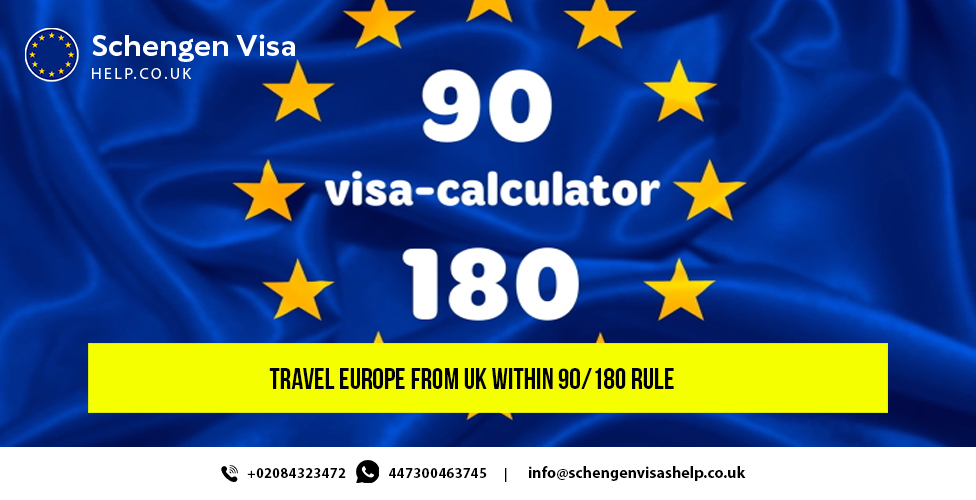Planning a Mediterranean escape or the multiple European city breaks from the UK? Then, understanding the Schengen Areas 90/180 Day Rule could be the difference between smooth travels and the serious border problems. Since the Brexit ended the freedom of movement in January 2021, this regulation now controls exactly when and how long you can visit the 29 European countries.
This guide explains everything you need to know about staying compliant with the Schengen visa 90/180 rule while maximising your European adventures with a Schengen visa from UK.
Quick Summary – Planning a hop from the UK to Schengen destinations like Portugal, Spain, or other countries now revolves around the Schengen 90 in 180 rule. You can roam among the 29 countries for a total of 90 days, counted on a rolling window that looks back six months to determine the number of stays you have left. Overstay, and you could face sharp fines, deportation, and bans, all logged automatically by the new Entry/Exit System. Use the EU Schengen calculator, keep documents, build buffer days, and slot in the non-Schengen breaks too, for a hassle-free visit experience.
The Schengen Visa’s 90-day rule allows the travellers to stay or move across the entire Schengen zone (group of 29 EU countries) as one single destination. The travellers, including those from the UK, can move/stay in the area for a maximum of 90 days within any rolling 180-day time duration. This applies to both the holders of Schengen visas and those travelling the Schengen visa-free.
The Schengen Area in 2025 includes the 29 countries and allows the seamless travel across borders without passport checks for the Schengen visa holders or travellers who can enter visa-free. These countries form one large travel zone, making it easy to explore the top destinations of the Europe.

The Schengen 180-day rule works on the rolling lookback period. This means that on any day of your visit/stay in the Schengen, you look back 180 days. Then, count how many days you have spent in the Schengen area – it must exceed the 90 day limit.
Pro Tip: Use the official EU Commission Schengen Calculator or the gov.uk resources to track your days. This will help you avoid overstaying!

UK travellers who overstay the Schengen stay limit often lead to the serious immigration violations along with heavy consequences. Here is what you risk if you break the Schengen Areas 90/180 Day Rule:
| Did you know? The new EU Entry/Exit System (EES), launched in the October 2025, automatically tracks your stay. This means detecting overstays under the Schengen visa rules in the UK becomes much easier for the authorities. That is why it is crucial to respect your allowed stay to avoid the fines or other penalties! |

Planning your trip from the UK to the Schengen area wisely can help you maximise your Schengen days. You can also avoid overstays while exploring the best destinations in the Europe. Here are some tips to make this happen:
The Schengen Areas 90/180 day rule fundamentally shapes how you explore Schengen from the UK post the Brexit era . Respecting the 90-day stay duration within any 180-day rolling window protects you from the fines or other penalties. Also, with the Entry/Exit System now digitally monitoring every crossing since the October 2025, miscalculations of the stay durations will no longer happen.
This means your European adventures deserve the proper planning, which starts with booking a Schengen visa appointment from UK. Wondering if this process is too complicated or will take up a lot of time?
Then, apply through a professional visa agency in London like SCHENGEN VISA HELP. Our experts ensure blazing-fast appointment scheduling so that you can fast-track your visa acquisition!
Ready to explore the Schengen responsibly? Get the visa, align your stay within the 90/180-day rule and travel with complete confidence!
The short-stay Schengen visas have a validity of up to 3 months or 90 days within a 180-day timeframe.
Yes, since the year 2021 from January, UK citizens must follow the Schengen Area’s 90/180-day rule as they are now treated as third-country nationals. Also, you can visit the Schengen region for around 90 days in any 180-day period.
No, briefly leaving the Schengen area does not reset your 90-day allowance. Instead, the uses a rolling 180-day window where all the days spent in the zone count towards your stay limit regardless of the exits.
No, Ireland and Cyprus remain outside the Schengen area despite being the EU members. However, the time spent in these countries does not count toward your 90-day Schengen limit.
No, the 90/180 day rule only covers the tourism and the business activities like the meetings or conferences. This means, paid employment, even the remote work for the non-EU companies, is not permitted.
Yes, even if you are only transiting through a Schengen airport, the day counts towards your 90-day allowance – if you pass through the passport control. However, airside transit without entering the Schengen area typically does not count. But, always verify with the border officials.
Yes, you may appeal the entry bans through the country which imposed the ban. The grounds may include humanitarian reasons, procedural errors or the exceptional circumstances.
Yes, the Schengen Areas 90/180 rule applies to travellers of all ages which includes the infants and children.